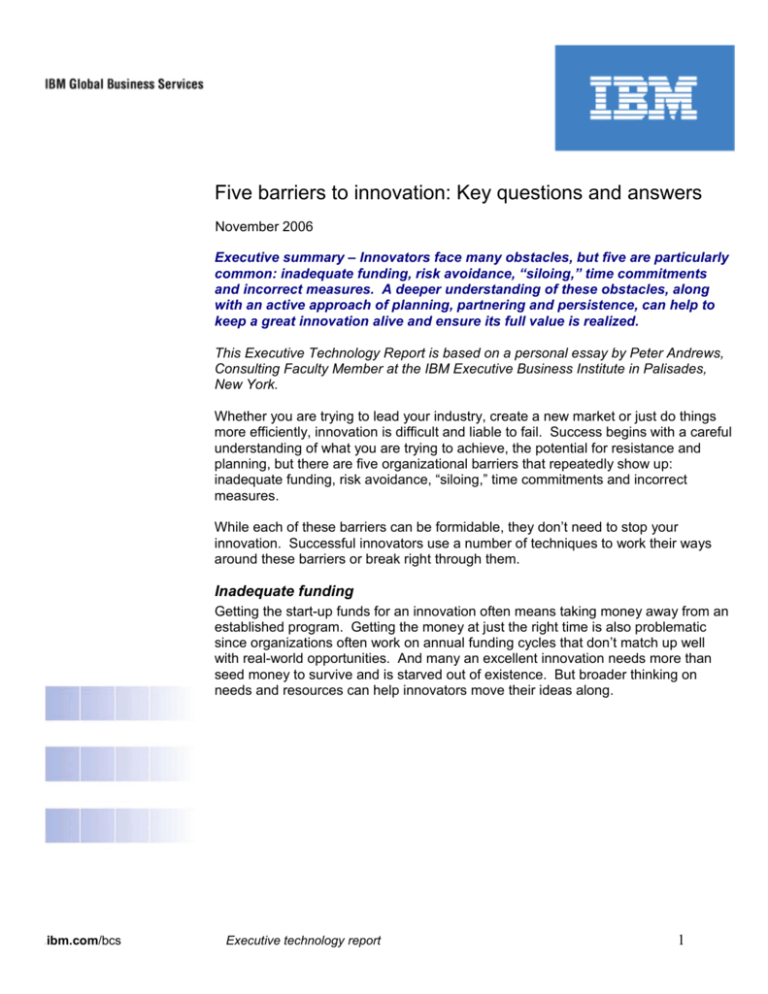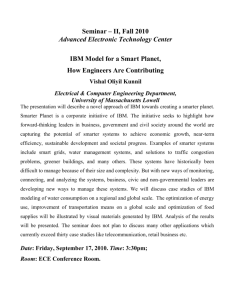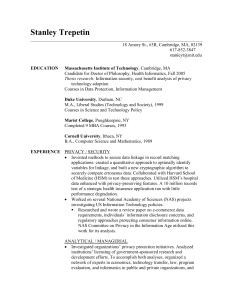
Five barriers to innovation: Key questions and answers
November 2006
Executive summary – Innovators face many obstacles, but five are particularly
common: inadequate funding, risk avoidance, “siloing,” time commitments
and incorrect measures. A deeper understanding of these obstacles, along
with an active approach of planning, partnering and persistence, can help to
keep a great innovation alive and ensure its full value is realized.
This Executive Technology Report is based on a personal essay by Peter Andrews,
Consulting Faculty Member at the IBM Executive Business Institute in Palisades,
New York.
Whether you are trying to lead your industry, create a new market or just do things
more efficiently, innovation is difficult and liable to fail. Success begins with a careful
understanding of what you are trying to achieve, the potential for resistance and
planning, but there are five organizational barriers that repeatedly show up:
inadequate funding, risk avoidance, “siloing,” time commitments and incorrect
measures.
While each of these barriers can be formidable, they don’t need to stop your
innovation. Successful innovators use a number of techniques to work their ways
around these barriers or break right through them.
Inadequate funding
Getting the start-up funds for an innovation often means taking money away from an
established program. Getting the money at just the right time is also problematic
since organizations often work on annual funding cycles that don’t match up well
with real-world opportunities. And many an excellent innovation needs more than
seed money to survive and is starved out of existence. But broader thinking on
needs and resources can help innovators move their ideas along.
ibm.com/bcs
Executive technology report
1
Questions to ask
• How far can we get without money? Do we need money?
• What sources of money are there?
• When do we need money?
• How much money do we need?
• Do we have any natural partners? Who benefits and how?
Possible answers
• Use the resources of informal networks to get things started. Call in favors.
• Break up the plan and simplify it to create shorter term successes.
• Do a creative inventory of available funding sources.
• Don’t build everything from scratch – leverage other work or take advantage of
“good enough” substitutes.
• Assess the full potential so that those who might realize value can be enlisted as
allies. Then sell the potential allies on the idea.
Risk avoidance
Most of us won’t run toward risks. We want to maintain our health, wealth and
peace of mind. But no progress is made without calculated risk taking. Since
people know that innovation is risky, many people run away from it. In fact, some
organizations habitually play the game of finding things that could go wrong. Many
of the classic responses (“We’ve never done this before”; “This failed when we tried
it before”) come up almost as a reflex. Once risks are identified, innovation is often
stopped. But a clear-eyed view of risks balanced against benefits can create an
environment where innovation is nurtured rather than killed.
Questions to ask
• Do we use standard methods for measuring risks and benefits?
• Do we use the appropriate risk assessment measures for innovations?
• Do we measure the risks of not innovating?
• Do we measure the benefits?
ibm.com/bcs
Executive technology report
2
Possible answers
• Learn about and promote effective risk assessment methods.
• Put the risk of innovation on the right person/organization.
• Find and develop supporters.
• Anticipate objections and provide both logical replies and stories that create
contexts for ideas.
• Test small on a small scale and create prototypes.
• Dramatize benefits.
• Encourage a portfolio approach, using options.
• Give people reasons to feel safe.
• Show you take seriously the safety of sponsors, participants and other
stakeholders by acknowledging and mitigating their risks.
“Siloing”
Organizations seek to protect create their identities, get proper credit, sustain
themselves and protect themselves. That’s why they create boundaries, assign
responsibilities and put rules in place. No matter how artificial the divisions and
processes are, they are usually defended – even when ignoring them is to
everyone’s advantage.
By nature, innovations tend to cross boundaries and create new categories. It’s not
unusual to see competing claims of ownership and disputes about authority. Deals
break down over who will run things and how imagined profits will be divided. As a
result, innovations that might benefit the whole enterprise are killed by organizations
that don’t benefit themselves, don’t see their benefits or don’t get a “fair share” of
benefits. But a better understanding of the needs and concerns of organizations can
be a starting point for managing the natural organizational conflicts innovation
creates.
Questions to ask
• Do all stakeholders benefit?
• Do all stakeholders understand how they will benefit?
• What are the mission statements of affected organizations? What are their rules?
• Who are the decision makers?
• How have innovations been handled in the past?
ibm.com/bcs
Executive technology report
3
Possible answers
• Include all major stakeholders in the creation of the innovation and help ensure
they are fairly rewarded.
• Create clear value propositions for all stakeholders.
• Actively manage stakeholders, keeping them aligned and informed.
• Get a deep understanding of the real concerns and interests of different
organizations and the boundaries within which they must work to succeed.
• Work to know the people involved as people, not just roles.
• Understand which choices would give others a “veto” on your idea and work to
avoid those choices.
• Innovation often creates winners as well as losers – it may be necessary not to
engage with some stakeholders, to “fly under the radar.”
Time commitments
Time is a scarce and precious commodity. One of management’s jobs is to verify
that minutes are productively filled. And while enlightened management will invest
some of workers’ on-the-job time in education, experimentation, relationships,
personal growth and health, it’s difficult to prove that such investments pay off. Even
worse, such investments may not pay off in a timely way (for example, quick enough
for returns to be apparent through a quarterly measurement) for a sponsoring
organization. But increasing the value, benefits and urgency of an innovation will
tend to free up time for work on it.
Questions to ask
• Is the innovation worth the time of the people involved?
• What are the competing claims on time?
• What is the minimum amount of time each participant must dedicate to help ensure
success?
• What are the real world timings (such as releases of competitive products) that
require milestone achievements?
• Where is there flexibility in the calendar and schedule?
ibm.com/bcs
Executive technology report
4
Possible answers
• Do triage on assignment lists.
• Let others do more of the work.
• Make personal commitments to others in your social network.
• Reallocate benefits so the innovation can compete better for the time of key
participants.
• Create small successes that encourage participants to free up more time.
Incorrect measures
For many organizations, revenue, profits and market share are the only measures
used. These are easier to quantify than intangibles such as reputation, knowledge,
attractiveness to talent, leadership and other assets that make major contributions to
the true value of an enterprise.
Most innovations that matter are difficult to explain in terms of return on investment
(ROI). Even those innovations that have the potential to disrupt or create new
markets may suffer by comparison when put up against more pedestrian projects as
they grind through a standard budgeting process. But by expanding the view of
measures and including decision makers in the process of creating new measures,
it’s often possible to avoid the ROI trap.
Questions to ask
• How do we measure success?
• Can we expand our measures of success?
• Should we have different measures for different investments?
• Are our investments balanced to sustain the present and create the future?
• What measurements are leading enterprises using?
ibm.com/bcs
Executive technology report
5
Possible answers
• Organizations can inventory possible measures, their characteristics and their
value.
• Measures that are compelling to all stakeholders can be developed in joint
workshops.
• Enterprises that take a portfolio approach can establish different measures for
different kinds of investments.
This isn’t the full set of barriers innovations can face. Lack of leadership,
infrastructure limits, property rights and many others can get in the way of your great
ideas. And the answers above are neither universal nor complete. The creativity of
your team, your network and your friends may have answers that are different and
more appropriate to your needs.
In fact, the most effective way to overcome barriers is to get into a discussion with a
group of colleagues and find out how they’ve been able to work through problems.
Their solutions will be complete and specific. And the answers they have will be
associated with themselves, a future resource for further guidance when an answer
just isn’t working for a new opportunity.
There’s an added benefit to starting these discussions. The most valuable asset for
any innovator is his or her network. Advice, complaints, mentoring and “war stories”
can all become a basis for strengthening social bonds and building relationships.
Working together to solve common problems is an effective way to establish or
revitalize these essential networks. Effectively, working on barriers with your
network does more than solve problems. It creates new opportunities and can help
you to fully realize the potential of your idea.
Technology to watch
Authorization and authentication tools
Collaboration tools
Interruption management
Risk management
Wikis
ibm.com/bcs
Executive technology report
6
References
Andrews, Peter. “Enemies of innovation: What they look like, and how not to become
one.” IBM Executive Business Institute. October 2005. http://www935.ibm.com/services/us/index.wss/multipage/imc/executivetech/a1022675/1?cntxt=
a1005266.
Andrews, Peter. “Time for change: Innovation in an era of overtime and budget
cuts.” IBM Executive Business Institute. August 2002.
http://www935.ibm.com/services/au/index.wss/multipage/igs/executivetech/a1006406?cntxt=a1
005069.
Andrews, Peter. “Tough measures: Making a material difference.” IBM Executive
Business Institute. May 2005.
http://www935.ibm.com/services/us/index.wss/multipage/imc/executivetech/a1011233/1?cntxt=
a1000401.
“Expanding the Innovation Horizon: The Global CEO Study 2006.”
IBM Corporation. March 2006. http://www.ibm.com/bcs/ceostudy.
Kamm, Lawrence. “Responses to your new ideas.” Consulting Engineering.
http://www.ljkamm.com/inov.htm A collection from sympathetic to hostile.
Pollard, Dave. “Drucker on innovation.” How to Save the World. November 12, 2003.
http://blogs.salon.com/0002007/categories/businessInnovation/2003/11/13.html#a51
5 (Go to the original book, Innovation and Entrepreneurship, at The Business World
According to Peter F. Drucker, http://www.peterdrucker.com/books/0887306187.html, or read the precis in this blog.)
Schultz, Dr. Wendy L. “Creativity: Concepts and tools.” Infinite Futures: Foresight,
Training and Facilitation.
http://www.infinitefutures.com/resources/frm/frmcreativity.html. See especially the
Innovation Roles list.
ibm.com/bcs
Executive technology report
7
“Team dimensions profile: Helping people work more effectively in teams.”
Momentum Coaching. http://www.momentumcoaching.com/care.html.
“Primary difference between innovation and operations.” Ten3 Business e-Coach.
http://www.1000ventures.com/business_guide/innovation_vs_operations.html.
Habits that block creativity.
http://www.carleton.ca/~gkardos/88403/CREAT/Block4.html.
Meyer, Marcy. “Innovation Roles: From Souls of Fire to Devil's Advocates.” The
Journal of Business Communication. October 1, 2000.
About this publication
Executive Technology Report is a monthly publication intended as a heads-up on
emerging technologies and business ideas. All the technological initiatives covered in
Executive Technology Report have been extensively analyzed using a proprietary IBM
methodology. This involves not only rating the technologies based on their functions
and maturity, but also doing quantitative analysis of the social, user and business
factors that are just as important to its ultimate adoption. From these data, the timing
and importance of emerging technologies are determined. Barriers to adoption and
hidden value are often revealed, and what is learned is viewed within the context of
five technical themes that are driving change:
Knowledge Management: Capturing a company's collective expertise wherever it
resides – databases, on paper, in people's minds – and distributing it to where it can
yield big payoffs
Pervasive Computing: Combining communications technologies and an array of
computing devices (including PDAs, laptops, pagers and servers) to allow users
continual access to the data, communications and information services
Realtime: "A sense of ultracompressed time and foreshortened horizons, [a result of
technology] compressing to zero the time it takes to get and use information, to learn, to
make decisions, to initiate action, to deploy resources, to innovate" (Regis McKenna, Real
Time, Harvard Business School Publishing, 1997.)
ibm.com/bcs
Executive technology report
8
Ease-of-Use: Using user-centric design to make the experience with IT intuitive, less painful
and possibly fun
Deep Computing: Using unprecedented processing power, advanced software and
sophisticated algorithms to solve problems and derive knowledge from vast amounts
of data
This analysis is used to form the explanations, projections and discussions in each
Executive Technology Report issue so that you not only find out what technologies are
emerging, but how and why they'll make a difference to your business. If you would
like to explore how IBM can help you take advantage of these new concepts and
ideas, please contact us at insights@us.ibm.com. To browse through other
resources for business executives, please visit
ibm.com/services
Executive Technology Report is written by Peter Andrews, Consulting Faculty, IBM
Executive Business Institute, and is published as a service of IBM Corporation. Visit
ibm.com/ibm/palisades
Copyright ©1999-2006 IBM Corporation. All rights reserved.
IBM and the IBM logo are trademarks or registered trademarks of International
Business Machines Corporation in the United States, other countries, or both.
Other company, product and service names may be trademarks or service marks of
others.
References in this publication to IBM products and services do not imply that IBM intends to
make them available in all countries in which IBM operates.
G510-6342-00
ibm.com/bcs
Executive technology report
9







